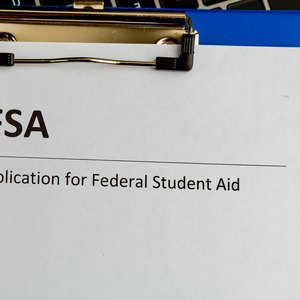
Most college students have to take out loans to pay for their tuition and expenses. Students want to get loans with the lowest interest rates and the most lenient repayment options. Another objective to getting the right student loan is not to have a loan amount that is more than is absolutely necessary so that you don’t strap yourself financially with high monthly payments after graduation.
You will also need to understand the definition of half-time enrollment, grace periods, interest payment and consolidation loans. Studentaid.gov is a good place to begin.
Most important, there are two types of student loan programs: federal and private. Let's look at the advantages and disadvantages of each loan type to find out which loan will work best for your higher education needs.
What is the Free Application for Federal Student Aid?
The journey to find a loan to pay for your college tuition and expenses starts with filling out a Free Application for Federal Student Aid (FAFSA). The federal government, states, colleges and other financial institutions use this form to analyze the applicant’s needs and eligibility for financial aid. A student must submit a FAFSA to request financial assistance for each academic year they're in college.
The financial aid office at your college will analyze your application and cost of attendance and let you know how much financial aid you can receive in addition to which grants, scholarships and work-study programs that you may be eligible for.
What are Federal Student Loans?
Federal student loans are loans that are issued by the U.S. government. Most federal loans don't require the applicant to have a credit check that indicates good credit history or a cosigner. Almost every high school graduate is eligible for a federal student loan.
Federal loans are based on your financial needs and year in school. They usually have more flexible terms than private loans.
Federal loans generally have lower interest rates than private loans. Interest rates are set by Congress and remain fixed for the full term of the loan.
However, the amount you can borrow in federal loans is limited. There is a limit on the total amount you can borrow and a restriction on the amount per year. Undergraduates can borrow a total of $57,500 and $12,500 each year. Graduate students are allowed $138,500 in total and $20,500 annually. The amounts will vary depending on the student's year in school and whether they are dependent or independent.
The U.S. Department of Education also issues Direct Plus Loans. These federal loans are available to eligible parents and graduate or professional students at schools particpating in the Direct Loan Program.
Federal loans have beneficial features such as the ability to make loan payments in proportion to your income after you graduate. They even have loan forgiveness programs if you work for a certain number of years in public service.
Federal student loans come in two types for student loan borrowers: subsidized and unsubsidized
What is a Subsidized Federal Loan?
Subsidized federal loans are only available to undergraduate students with verifiable financial need. They are the most desired type of federal loan because the government will pay the interest on your student loan debt for as long as you're in school.
However, subsidized loans have a restriction known as the 150 percent time limit. This means there is a limit on the number of years that it takes to receive a degree. The purpose is to keep students on schedule to finish their degree requirements in a reasonable amount of time.
For example, if you are enrolled in a program that normally takes four years to complete, the 150 percent rule will give you six years to obtain your degree. If you are going through a two-year program, you will have three years to complete the requirements for a degree.
If a student exceeds this time limit, they will no longer be eligible for additional subsidized loans.
Even worse, the interest paid previously by the government on any existing subsidized student loans will be lost, and the accrued interest will be added to the balance of the loan when student loan payments begin.
Read More: How do I Get My Student Loan in Cash?
What is an Unsubsidized Federal Loan?
Unsubsidized federal loans are offered to undergraduates, graduates and students for professional degrees and do not consider financial need. Unlike subsidized loans, interest on unsubsidized loans begins as soon as the money is dispersed and continues to accrue while you're in school. The accrued interest will be added to the loan balance when you start to make payments.
Unsubsidized federal loans have higher loan limits than subsidized loans
What are Private Student Loans?
Private student loans are the most restrictive and usually have the least favorable terms compared to federal student loans. Private loans often have higher interest rates and will require a cosigner if the borrower does not have a credit history, which most undergraduate students do not have since they have no income and no credit cards. Most private lenders require applicants to have a credit score of at least 670.
In some cases, private lenders may offer loans with variable rates, which can create a risk of higher payments when interest rates are rising. Interest rates on private student loans depend on you and your cosigner's credit score.
Unlike the maximum borrowing limits imposed on federal loans, private loans do not have any such limitations. However, private loans do not have the flexible repayment plans offered on federal loans, such as the income-driven payment option. Nor do private loans offer any possibilities of loan forgiveness for working in public service occupations, which federal loans offer.
You should only consider private loans as needed to fill a financial gap after you've exhausted your options with federal loans. You don’t use the FAFSA to apply for a private loan but instead must apply directly to a bank, credit union or an online lender for the funds to cover your education expenses.
Should You Refinance a Student Loan?
Refinancing your student loan makes sense if you can get a lower interest rate that will make a difference in your finances. If you have been out of college for a few years and have been able to establish a good credit history with consistent payments, then you should consider refinancing or consolidation of your loans if:
- The difference in interest rates is enough to make a difference
- You have private student loans that aren't eligible for public service loan forgiveness or conversion to an income-driven repayment plan, like federal loans
- You have a student loan with a high variable interest rate
- Your financial health has improved and you're able to get a lower interest rate because of a better credit score
You shouldn't consider refinancing if:
- You have federal loans and could be facing a drop in income
- You're working in an occupation that makes you eligible for public service loan forgiveness
- You've recently declared bankruptcy or defaulted on other student debt
- Refinancing would result in adding a significant number of years to your student loan repayment
In general, it makes more sense to refinance private student loans rather than federal loans because the federal loans have more options to work with borrowers in the event of financial difficulties. The recent government programs for deferrment and forbearance of student loans resulting from coronavirus (COVID-19) pandemic problems are such an example. Private student loan lenders and those servicing the loans have not been as lenient or accommodating.
References
Writer Bio
James Woodruff has been a management consultant to more than 1,000 small businesses. As a senior management consultant and owner, he used his technical expertise to conduct an analysis of a company's operational, financial and business management issues. James has been writing business and finance related topics for work.chron, bizfluent.com, smallbusiness.chron.com and e-commerce websites since 2007. He graduated from Georgia Tech with a Bachelor of Mechanical Engineering and received an MBA from Columbia University.

